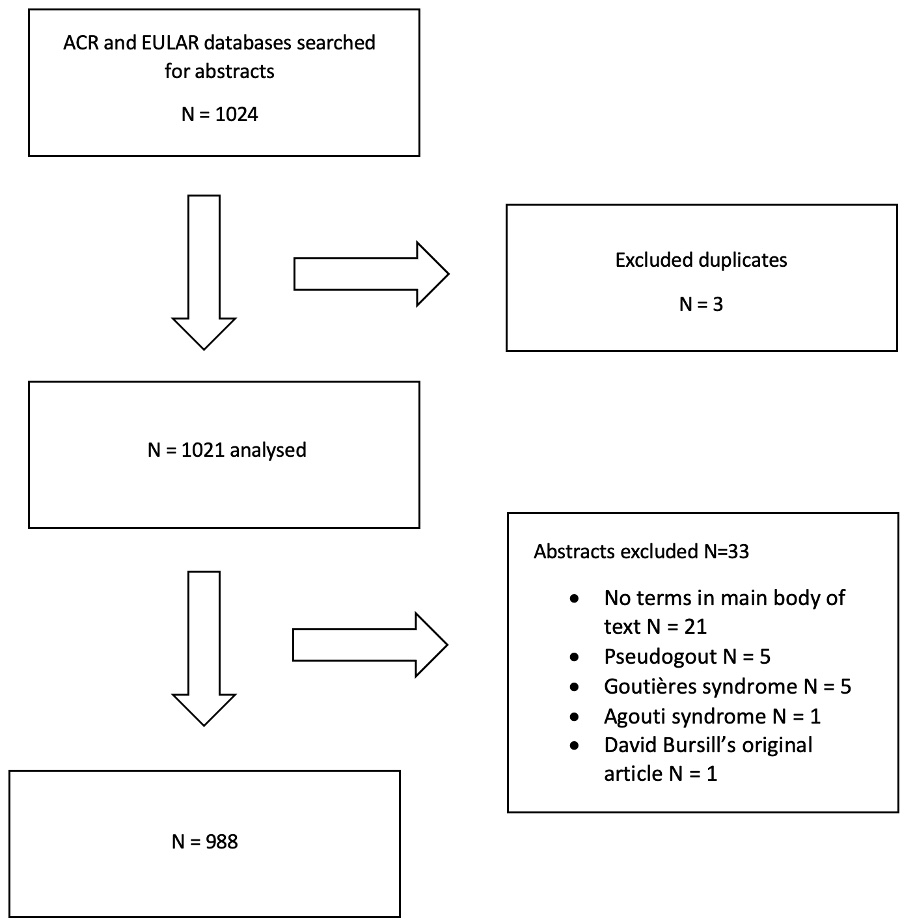Session Information
Date: Sunday, November 12, 2023
Title: (0229–0251) Metabolic & Crystal Arthropathies – Basic & Clinical Science Poster I
Session Type: Poster Session A
Session Time: 9:00AM-11:00AM
Background/Purpose: Uniform terminology with standardised definitions for the various elements and states of a disease ensure accurate and consistent technical communication. In 2019 the Gout and Crystal Arthritis Network (G-CAN) published consensus statements for the nomenclature of disease elements and disease states in gout. The aim of this study was to determine adherence to the G-CAN consensus statements since publication.
Methods: ACR and EULAR conference abstracts were searched using online databases for the keywords “gout” “urate” “uric acid” “hyperuricaemia” “tophus” and/or “tophi” before and after-publication of the consensus statements (01/01/2016-31/12/2017 and 01/01/2020-31/12/2021 (respectively)). Abstracts were manually searched for labels used to reference gout disease elements and states. Labels were extracted from text, figures, and tables. Use of the G-CAN agreed labels, as well as alternatives, were compared between the two time periods and between abstracts that included a G-CAN consensus statement author and those that did not in 2020/2021. Use of the term ‘chronic gout’, which G-CAN advised should be avoided, was also compared between the two time periods.
Results: There were 988 abstracts included in the analysis; 596 in 2016/2017 and 392 in 2020/2021. One or more G-CAN agreed labels were used in 445/596 (74.9%) of abstracts in 2016/2017, increasing to 311/392 (79.4%) in 2020/2021 (p=0.006). Use of the agreed labels ‘urate’, ‘gout flare’, and ‘chronic gouty arthritis’ increased between the two periods. There were 219/383 (57.2%) abstracts with the agreed label ‘urate’ in 2016/2017 compared to 164/232 (70.7%) in 2020/2021 (p=0.001). There were 60/175 (34.3%) abstracts with the agreed label for ‘gout flare’ in 2016/2017 compared with 57/109 (52.3%) in 2020/2021 (p=0.003). Only 1/35 (2.9%) abstracts used the agreed label for ‘chronic gouty arthritis’ in 2016/2017 compared to 6/16 (37.5%) in 2020/2021 (p=0.02). Abstracts with consensus statement authors used the agreed labels in 87.4% of abstracts, compared to 74.5% without in the 2020/2021 period (p< 0.001). Use of the label ‘chronic gout’ reduced between the two time periods.
There were 29/596 (4.9%) abstracts in 2016/2017 that used the label ‘chronic gout’ compared with 8/392 (2.0%) abstracts in 2020/2021 (p=0.02).
Conclusion: Use of the G-CAN agreed gout labels has increased but gout nomenclature remains imprecise. Additional efforts are needed to ensure consistent use of agreed nomenclature for gout in the scientific literature.
To cite this abstract in AMA style:
Prendergast E, Dalbeth N, Bursill D, Frampton C, Stamp L. Adherence to the Gout and Crystal Arthritis Network (G-CAN) Consensus Statements for Gout Nomenclature [abstract]. Arthritis Rheumatol. 2023; 75 (suppl 9). https://acrabstracts.org/abstract/adherence-to-the-gout-and-crystal-arthritis-network-g-can-consensus-statements-for-gout-nomenclature/. Accessed .« Back to ACR Convergence 2023
ACR Meeting Abstracts - https://acrabstracts.org/abstract/adherence-to-the-gout-and-crystal-arthritis-network-g-can-consensus-statements-for-gout-nomenclature/

